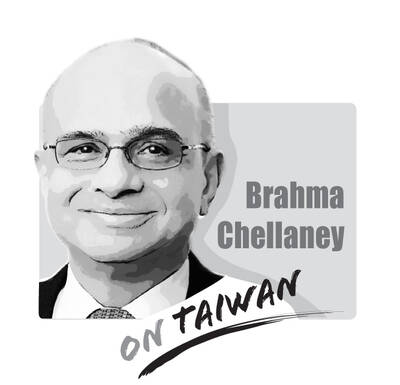More than 400 domestic COVID-19 cases have been reported in Taiwan this year, and new daily case counts remain in the double digits.
The CECC on Monday extended a level 2 COVID-19 alert for two more weeks, slightly tightening mask rules, but allowing indoor dining and not imposing gathering limits.
“We need to get on with our lives, so everyone should be responsible for disease prevention and get vaccinated, as remaining vigilant has become the ‘new normal,’” Minister of Health and Welfare Chen Shih-chung (陳時中), who heads the Central Epidemic Command Center (CECC), said on Thursday.
Many people have expressed concerns about increased infection risks as people move about during the Lunar New Year holidays. This could lead to a surge in cases, and some questioned why the alert was not raised to level 3, as the local situation has met last year’s criteria of “having more than three local clusters of infections within one week.”
Responding to public concerns, the center on Thursday released a set of COVID-19 prevention guidelines for the holidays, mainly reminding people to practice personal protective measures, avoid crowded gatherings with strangers, get fully vaccinated, wear a mask and practice social distancing when meeting people.
Chen said that family gatherings are an important part of family relationships, and celebrations can take place as long as people practice preventive measures.
The policies now are much looser than those implemented during the Dragon Boat Festival long weekend in June last year, when the government reduced public transportation and urged people to avoid traveling home.
“Zero COVID is not our goal, but it is our attitude in conducting disease prevention operations,” said Victor Wang (王必勝), deputy head of the CECC’s medical response division and the center’s on-site commander at several large cluster infection sites.
The minister’s mention of the “new normal” seems to suggest that the center is shifting toward a risk mitigation strategy, as eradicating the highly transmissible Omicron variant of SARS-CoV-2 is difficult, and tools to protect people against serious illness and death have become widely available.
Instead of significantly tightening domestic restrictions and imposing fines, the center is asking everyone to assess their risk and shoulder the responsibility of disease prevention.
However, when the CECC emphasizes a rolling review of policies in response to the rapidly changing COVID-19 environment, it can be confusing to the public. Previous criteria for issuing alert levels, conducting mandatory testing and placing contacts under isolation are no longer reliable, and the visions for a “new normal” remain indistinct.
What does it mean when the center is taking a “zero COVID” approach, yet people must prepare to live with the virus? How does the government plan to balance public health and reduce disruption to society? And how do people assess their risk and make the best choices if living with COVID-19 is inevitable?
Aside from reporting the latest daily case counts, contact tracing progress and measures taken to contain the spread of infections, it would be helpful if the CECC offered analytical data from scientific studies on the effectiveness of non-pharmaceutical interventions and the recommended vaccine doses needed to protect people from COVID-19 infection or severe disease.
The government should review its isolation policy and other guidelines that have become less effective in defeating the Omicron variant. It should also inform the public about the nation’s healthcare capacity. These measures along with clear communication would help the public remain relatively safe and live with COVID-19.

Taiwan stands at the epicenter of a seismic shift that will determine the Indo-Pacific’s future security architecture. Whether deterrence prevails or collapses will reverberate far beyond the Taiwan Strait, fundamentally reshaping global power dynamics. The stakes could not be higher. Today, Taipei confronts an unprecedented convergence of threats from an increasingly muscular China that has intensified its multidimensional pressure campaign. Beijing’s strategy is comprehensive: military intimidation, diplomatic isolation, economic coercion, and sophisticated influence operations designed to fracture Taiwan’s democratic society from within. This challenge is magnified by Taiwan’s internal political divisions, which extend to fundamental questions about the island’s identity and future
Taiwan People’s Party (TPP) Chairman Huang Kuo-chang (黃國昌) is expected to be summoned by the Taipei City Police Department after a rally in Taipei on Saturday last week resulted in injuries to eight police officers. The Ministry of the Interior on Sunday said that police had collected evidence of obstruction of public officials and coercion by an estimated 1,000 “disorderly” demonstrators. The rally — led by Huang to mark one year since a raid by Taipei prosecutors on then-TPP chairman and former Taipei mayor Ko Wen-je (柯文哲) — might have contravened the Assembly and Parade Act (集會遊行法), as the organizers had
The narrative surrounding Indian Prime Minister Narendra Modi’s attendance at last week’s Shanghai Cooperation Organization (SCO) summit — where he held hands with Russian President Vladimir Putin and chatted amiably with Chinese President Xi Jinping (習近平) — was widely framed as a signal of Modi distancing himself from the US and edging closer to regional autocrats. It was depicted as Modi reacting to the levying of high US tariffs, burying the hatchet over border disputes with China, and heralding less engagement with the Quadrilateral Security dialogue (Quad) composed of the US, India, Japan and Australia. With Modi in China for the
The Chinese Nationalist Party (KMT) has postponed its chairperson candidate registration for two weeks, and so far, nine people have announced their intention to run for chairperson, the most on record, with more expected to announce their campaign in the final days. On the evening of Aug. 23, shortly after seven KMT lawmakers survived recall votes, KMT Chairman Eric Chu (朱立倫) announced he would step down and urged Taichung Mayor Lu Shiow-yen (盧秀燕) to step in and lead the party back to power. Lu immediately ruled herself out the following day, leaving the subject in question. In the days that followed, several